 |
 |
 |
 |
 |
 |
 |
 |
 |
 |
 |
 |
 |
 |
 |
 |
 |
 |
 |
 |
 |
 |
 |
 |
 |
 |
 |
 |
 |
 |
 |
 |
 |
 |
 |
 |
 |
 |
 |
 |
 |
 |
 |
 |
 |
 |
 |
 |
 |
 |
 |
 |
 |
 |
 |
 |
 |
 |
 |
 |
 |
 |
 |
 |
 |
|
| Chapter Six : The 80's : Wrestling goes International |
|
|
|
(The American Way ?) |
|
|
|
In the beginning of 1980, Québec Wrestling was about to get another second wind. Grand Prix veteran Gino Brito, along with Frank Valois, former wrestler turned promoter and André the Giant, creates International Wrestling (the company name was Promotions Varoussac, which stands for VAlois, ROUSSimoff, and ACcocella, the first letters of their family names...). He puts under contract many of the wrestlers which have made prime time in both All Star Wrestling and Grand Prix Wrestling. Due to the popularity of a late night wrestling show on a nearby American channel affiliated with the ABC network, he also invites wrestlers from the Wide World Wrestling Federation. |
|
|
|
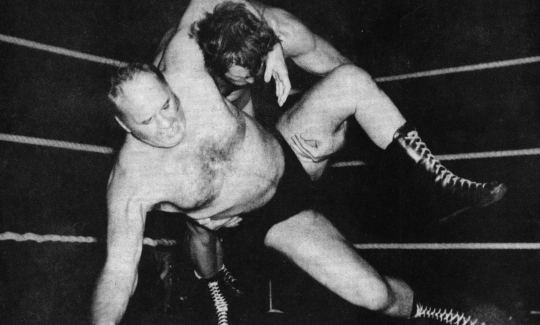 |
|
|
|
|
|
Frank Valois, in his glorious wrestling days... |
|
|
|
|
| Grand Prix Wrestling, before its folding, had a TV show made in the CHLT TV studios in Sherbrooke, Québec, in the 70's. The same studio is used again to broadcast the flagship show, called LES ÉTOILES DE LA LUTTE (Superstars of Wrestling, which was broadcast also in English on the CTV's CFCF 12 station with George Gannon at the anchor desk). It was a very popular show from 1980 to 1985, shown on Sundays at a time when everyone was supposed to go to church... |
|
|
| Many wrestlers were participating in that promotion. Among the vets were Brito itself, Michel Dubois, Raymond Rougeau, Tony Parisi, Neil Guay (the Hangman), Sailor White, Gilles Poisson, Maurice Vachon, Rick Martel, Frenchy Martin, etc. as well as new faces like Pierre Lebfèvre, Mike Vachon, Richard Charland, Louis Laurence, Alain Vigneault, Ludger Proulx, Armand Rougeau, Jacques Rougeau, etc. Even the midgets Little Beaver and Sky Low Low were there once in a while... |
|
|
|
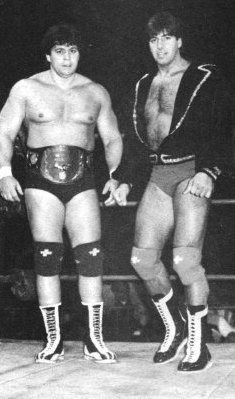 |
|
|
|
But mainly, it was Dino Bravo which was the focus in that promotion. Billed as the Canadian Strongman in the U.S. , Bravo would become the champ and keep the belt for more that five non-consecutive years. However, he would be the main target for several heels, many headed by the notorious Eddy Creatchman (back with his speeches) and later by the late Tarzan Tyler. |
|
|
Dino Bravo (left)
with Rick Martel
(archive) |
|
|
|
|
|
|
|
|
|
|
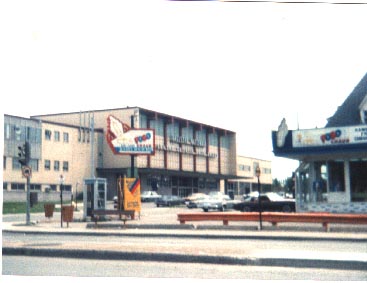 |
|
|
The main venue was again the Paul-Sauvé Arena. It was the most appropriate place for wrestling shows, especially that most of the shows will average at least 3000 persons per night. The shows were mostly presented on Monday nights, 48 nights per year. |
|
|
|
|
|
The Paul-Sauvé Arena in Montreal
Photo: Danielle LaFrance |
|
|
|
|
|
| The TV show and the dynamic organisation that was Varoussac (INTERNATIONAL WRESTLING) brought wrestling to new heights. In the newspapers, everyone was talking about the comeback of a controversial, but entertaining sport. And affordable as well... Fans fill arenas in every venue the federation passed in the province of Québec. |
|
|
| American wrestlers were also in demand due to that late night TV show. Wrestlers like Sargeant Slaughter, Hulk Hogan, Bob Backlund, Big John Studd, Stan Hansen, The Destroyer, Ken Patera ,were invited to the federation's shows. Another one, who started his career in Montréal, came back for several shows and fill out each time the Paul-Sauvé Arena : André the Giant ! |
|
|
|
 |
|
|
|
Everything went so well that Frank Valois had big plans for the promotion, especially bring some shows in the Montréal Forum, where many legendary wrestlers fought. It happened in July 1982, in a sold-out show which featured in the main event, a recently heel-turned Pat Patterson against Raymond Rougeau. It would came back in April 1983 with more success with 18.000 fans filling the arena ! |
|
|
|
|
|
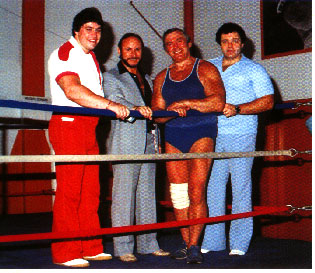 |
|
|
|
The Paul Sauvé Arena
Wrestling School:
from left to right:
Dino Bravo, Guy Hauray
Edouard Carpentier and
Gino Brito |
|
|
The federation created a pro wrestling school to train future wrestling hopes. Directed by Édouard Carpentier, the school was located at the Paul Sauvé Arena, assistant teachers were Gino Brito and Dino Bravo. One of the first graduates was Gino Brito Jr, son of Gino. |
|
|
|
|
|
|
|
|
|
|
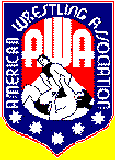 |
|
 |
|
|
|
With the association of Verne Gagné's AWA promotion, some wrestlers from Minnesota came into Montréal to challenge our wrestlers : Curt Hennig, Billy Robinson, Ric Flair, Greg Gagné, Jim Brunzell, Tom Zenk, Nick Bockwinkel, the Road Warriors and the Garvins came to challenge our wrestlers. Thus not forgetting that in 1983, Rick Martel won the coveted AWA championship belt against Jumbo Tsuruta. |
|
|
|
|
|
|
|
|
|
However, pro wrestling was about to be strongly popular in the U.S.. Vince McMahon Jr buys his ailing father's WWWF to create the World Wrestling Federation. Its goal is to internationalize wrestling by many phases. The first was to get a popular wrestler to promote and bring the fans all over. Fresh from his ROCKY III success, Terry Bullea, alias Hulk Hogan, would fit into the picture. Having won the championship in January 1984 against Iranian champ the Iron Sheik, wrestling would go into higher levels. Then, McMahon would tape the matches from a single venue (first, the former Felt Forum in New York, then a studio in Glen Falls, NY), then sell the tapes to TV channels across America and Canada. Then get into the lucrative promotional products. (Even a cartoon was made...) Finally, one by one, the WWF would buy major regional promotions to reunite under one federation and present several shows throughout the year. It also presented the first wrestling match in a video clip channel (MTV) and the first wrestling pay-per-view : WRESTLEMANIA in April 1985... |
|
|
|
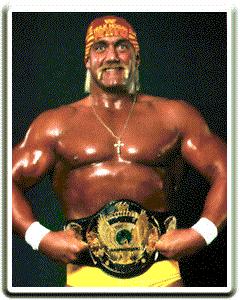 |
|
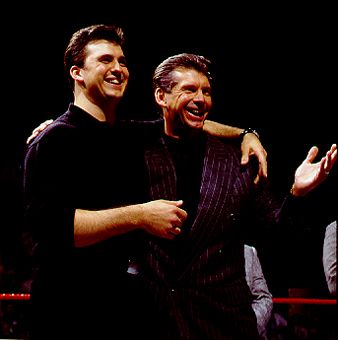 |
|
|
|
|
|
|
|
|
|
Vince McMahon (right)
with son Shane, heading
the WWF. |
|
|
|
|
|
Hulk Hogan, WWF champ |
|
|
|
|
|
|
|
| In Canada, Maple Leaf Wrestling was the first step to the WWF's quest to conquer the Canadian wrestling market. And INTERNATIONAL WRESTLING was about to be next. First, it purchased the rights to a WWF TV french version (with Edouard Carpentier as host...), and then co-host some shows with the promotion at the Montreal Forum in 1986... |
|
|
| With the WWF's strong influence, Quebec wrestling foundations were starting to crumble despite its success. In a certain point, the fans prefer seeing American wrestlers getting at it in a spectacular way each week rather than seeing two locals wrestling each other again and again... However, INTERNATIONAL WRESTLING hired new guns such as the Long Riders, Steve Strong, the Great Samu, Alofa the Polynesian Prince, the HeadHunters, Kamala the Ougandan Giant, and others. Summer 1985 was marked by one of the most popular rivalries ever done as the Rougeau Brothers and the Garvin Brothers took on each other at two memorable dates at the Montreal Forum. But on Christmas Eve 1985, Quebec Wrestling lose three of its main players in a car accident near Chicoutimi, Qc. Tarzan Tyler, his protégé Pierre Lebfèvre and referee Adrien DesBlois lose their lives during a severe snowstorm while coming back from a show in the latter city. Then, with the co-hosted shows with the WWF in 1986, some Québec wrestlers were about to be lured in the big leagues. |
|
|
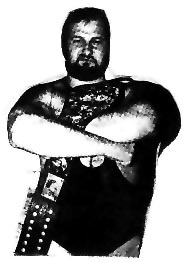 |
|
|
Pierre Mad Dog
Lebfevre,
a talent that left
us early in
Christmas Eve 1985 |
|
|
|
|
|
|
| Soon, Dino Bravo, the Rougeaus : Raymond and Jacques Jr, Rick Martel, Frenchy Martin, Louis Laurence, King Tonga and Tom Zenk would be signing contracts with the help of former member Pat Patterson. With these major INTERNATIONAL WRESTLING players leaving the Québec federation, it finally fell into forgetfullness. |
|
|
|
It folded in 1987... Gino Brito reunited the rest of those who wanted to carry the torch and created Super Pro Wrestling (SPW), a small promotion touring during the summer months around Québec. |
|
|
|
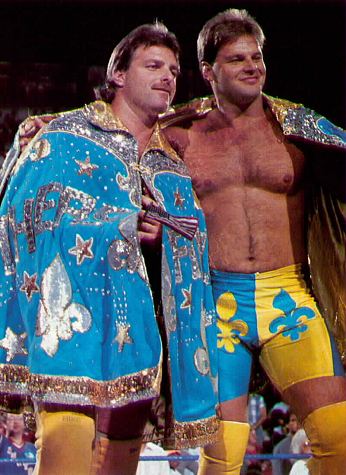 |
|
|
The Quebec wrestlers fared pretty well on wrestling shows. However, they were given the heavy roles of heels. But they didn't mind, because the majority of the WWF venues were American, European and even Australian... But when they came at the Forum for the occasionnal show, they were booed : quite a contrast for local heroes. We remember that Mad Dog Vachon did retire from the sport on a WWF show in 1987... |
|
|
|
|
The Rougeaus
Ray and Jacques Jr
in their WWF days... |
|
|
|
|
|
|
|
|
|
The 80's saw veterans come and go. Besides the death of Tyler, Lebfèvre and DesBlois cited above, wrestling great Johnny Rougeau passed away in May 1983 from cancer. Rougeau's story was at least special : in order to accept his fate, he wrote an excellent biography (edited by Québecor). Mad Dog Vachon retired in 1986 after a short shift at the WWF, but bad luck struck him in 1987 when he was victim of a hit-and-run while doing his jogging at his home town of Iowa City. Vachon lost his left leg due to this misfortune. A member of the Rougeau Family, Armand, saw his career broken when he was victim of a severe back injury in 1986 and was forced to retire from the sport. |
|
|
| With the influence of free TV, no one dared started another wrestling federation before 1989, when Ludger Proulx, Frank Blues and others would start Indy federations that would keep alive the flame of Quebec Pro Wrestling... |
|
|
|
Next chapter : 90's means Indys, and a new hope |
|
|
|
Back to the Legends Welcome page |
|
|
|
Copyright 1999, Productions Leduc 2000 ltd, Montreal, Qc
(Republished by DeUxKonE, 2004) |
|










